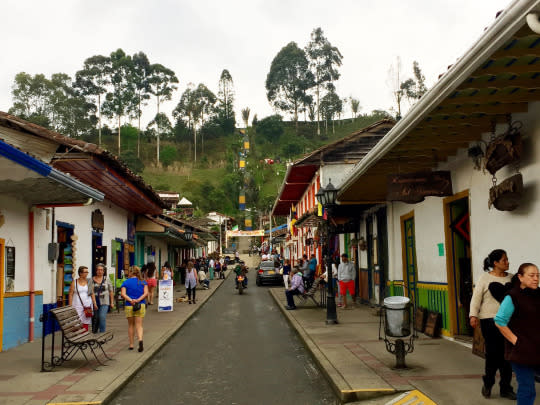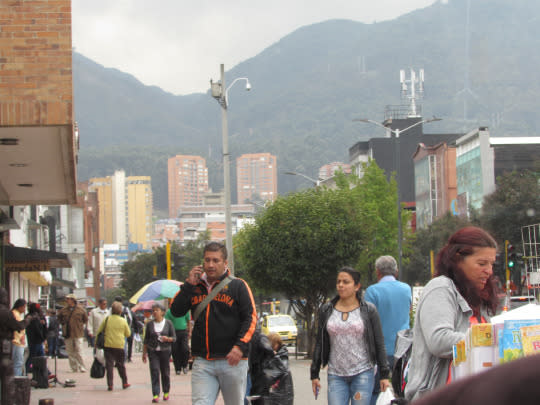Is Colombia Really Safe? A Firsthand Look.

The walled city of Cartagena is among the safest places you can visit in Colombia. (Photo: Greg Keraghosian)
I’ve walked through some scary places, from the poorer streets of Baltimore to Hezbollah territory in Lebanon, and through the sheer force of luck, I’ve never been harmed. But never did I think so much about safety as when I boarded an ordinary bus in Colombia — simply because of what happened to a friend on that same route three weeks earlier.
On the night of Halloween 2015, travel writer Anne Lowrey and her friend boarded a public bus bound from Armenia to Salento during their monthlong visit to the country. Children on the bus were dressed in costumes. Minutes into the 20-mile ride, armed robbers entered the bus, and one of them held a gun to her head. She lost everything, including her passport, money, and laptop. But at least she didn’t lose her life.
My own evening ride from Armenia’s airport to Salento — on a private bus — was dark and bumpy but uneventful. Over seven days, I easily traveled through some extraordinary landscapes that 10 years earlier would have been too dangerous to visit.
Did I feel safe in Colombia? Yes, and I’d recommend seeing the country to anyone. But I also had help with touring the country safely, and after some things that happened to others on my trip, I have some precautionary suggestions if you’re looking to go.
Related: Is Colombia Safe for Tourists?

The town of Salento. (Photo: Greg Keraghosian)
I was already familiar, you might even say fascinated, with Colombia’s bloodstained past and its recovering image as a safer tourist destination today. I’ve watched documentaries on Pablo Escobar, and I binge-watched Narcos on Netflix just days before I went.
Indeed, Colombia has come a long way since the horrific reign of the Escobar-led drug trade and guerrilla groups in the 1980s and ’90s. In 1991, there were 28,280 murders in the country, according to police statistics reported by El Tiempo. That’s 78 murders for every 100,000 people. And Medellín, Escobar’s hometown, was considered the world’s most violent city.

Street art in Cartagena. (Photo: Greg Keraghosian)
In 2014, Colombia saw 11,600 murders, according to the same statistics. And Medellin’s reported murder count of 653 in 2014 was its lowest in 35 years.
But no country can shrug off a long history of violence overnight, and dangers remain. The U.S. State Department issued a travel warning in June 2015 including the following statement: “Security in Colombia has improved significantly in recent years, including in tourist and business travel destinations such as Bogotá, Cartagena, Barranquilla, Medellín, and Cali. However, violence linked to narco-trafficking continues to affect some rural and urban areas.”
More specific to the horrific experience Lowrey suffered was a 2015 crime report issued by the Overseas Security Advisory Council, which facilitates the sharing of security information between the State Department and private sector. It includes the following: “Thefts and assaults occur frequently on public buses in urban and rural areas.”

Some miniature locals near Salento. (Photo: Greg Keraghosian)
The big difference between Lowrey’s late-night Armenia-Salento bus transfer and mine was that mine was private — it was arranged by the tour company Intrepid Travel. Even though the route is the main way to enter Colombia’s coffee region, you won’t find many warnings about it anywhere, and indeed Lowrey, a professional traveler who had done her research, had never heard one before she boarded — except for a last-minute warning from a local boy who helped her load her bag.
“Unfortunately, at that point I didn’t listen,” Lowrey said. “Lesson learned for me.”
Salento and the coffee region are growing in popularity with travelers, and for good reason — the scenery, with lush green valleys surrounded by the Andes mountains, is breathtaking and unspoiled. My hike of the misty Cocora Valley, with its towering wax palms, was the highlight of my trip, and I had a blast staying at a coffee farm/B&B called Hacienda Venecia.
But 10 years ago, that hike would have been too dangerous to take. The Cocora Valley was plagued by FARC guerrillas, and only recently has it started to catch on with backpackers and tour groups.
Related: Brave or Insane? This Woman Rode Local Buses in Colombia.

The incredible Cocora Valley, which was deemed too dangerous to visit 10 years ago. (Photo: Greg Keraghosian)
I got some background about the region’s bloody past from the owner of Hacienda Venecia, Juan Pablo Echeverri, during a coffee cupping demonstration. I could see the pain on his face as he closed his eyes while talking about it.
“The numbers are horrible, just horrible,” he said. “But it’s a new country. Tourism is helping us turn the page and see a new hope.”
Still, to anyone who wants to enter the coffee area, I suggest not taking a public bus, especially at night. Even if you hire a taxi, make sure you call one from a known, reputable company — do not hail one from the street or take solicitors. To take extra caution, go with a trusted tour group.
I likewise experienced Colombia’s rapid change near its Caribbean coast to the north, on my way to a pristine beach lodge named Playa Koralia. It, as well, was too dangerous to visit 10 years ago thanks to FARC and drug traffickers.

Juan Pablo Echeverri, the owner of a B&B in the coffee region. (Photo: Nathan Legiehn Photography)
“Now it is what it should be: paradise,” said my tour guide, Bogotá native Ana Gomez.
Although nothing scary happened to me in Colombia, I did see reminders of the risks. On my first night, in the capital city of Bogotá, two other people in my tour walked the red-light district at night. This would be unadvisable to even a seasoned traveler, and sure enough, the two were followed and then attacked by a pair of unarmed robbers who attempted to take their wallets. Only after the travelers ran shouting into the middle of the street and the surrounding cars honked their horns did the robbers flee.
“I blame it on my own foolishness for just the two of us going there,” one of them told me, adding that he still considered Bogotá a safe place.

A street at the center of Bogotá. (Photo: Greg Keraghosian)
Earlier that day Katie Jackson, another travel writer in my group, walked uphill toward the slums of Bogotá, wanting to learn about the people who live there. But on the way up she encountered a woman and the orphans she cares for. They immediately escorted her back down, saying it was too dangerous for her to be there.
When visiting Bogotá, your safest bet is to stick to the city center, which is heavily patrolled by the army.
That’s not to say visitors to Colombia should cower in fear or avoid contact with locals — you could even dance with them, as I did.
While in Cartagena, I took an evening tour that escorted us to four salsa clubs, and at each one we were the only gringos there. Not surprisingly we were stared at but only with curiosity. A couple of young men who didn’t know English waved me over to talk to them, and in my best broken Spanish I told them where I was from and how much fun I was having there. Then we high-fived and fist-bumped like we were buddies. I’ll never forget seeing my salsa group joined by a burly local man in a pink sparkly hat who danced like it was his last day on earth.
Related: The Wonderful Secret Places You Need to See in Colombia

Making an unexpected friend in a pink hat while salsa dancing in Cartagena. (Photo: Nathan Legiehn Photography)
Still, later that night there was an incident that didn’t involve locals, but the police. Around 2 a.m., two officers shook down someone in my tour as he walked alone — they reached for the money in his wallet and asked if he was carrying drugs even though he gave them no reason to think he was. It’s another reminder that you’re better off not being out in Colombia late at night, and that police in Colombia have a well-earned reputation for corruption.
After all this, would I recommend visiting Colombia? Absolutely. Despite what happened to my one friend, I know other female travelers who visited the country on their own without a problem. That’s the thing about risk, whether you’re in Colombia, Paris, or San Francisco: You just never know.

A local man in Cartagena. (Photo: Nathan Legiehn Photography)
Still, the margin for error is smaller here than some other places. I suggest all of these precautions when visiting Colombia:
If you’re at all concerned about logistics or safety, go with a tour group. There are plenty to choose from, including Intrepid and G Adventures.
If in the unlikely chance you are robbed, do not resist. That’s the most common factor in murders, and it’s how a tourist was killed in Medellín last year.
Don’t take public buses if you can help it, and only enter a taxi if you called it and you’ve verified the driver’s employer. One form of crime is to kidnap taxi riders and force them to withdraw their money from several ATMs.
Don’t accept a drink from a stranger. Some criminals spike their victim’s drink with the drug scopolamine, which could render a person unconscious for more than 24 hours. The OSAC crime report on Colombia mentions an estimated 50,000 scopolamine incidents per year.
Be very careful about where you go at night. If it feels at all sketchy and you don’t see police around, don’t go there.
Though you’re probably going to stand out if you’re American, don’t wear any flashy jewelry or clothing, and try not to flaunt what you have. If possible, leave your expensive electronics at home.
WATCH: Take That, Terrorism! 7 Ways to Travel Without Fear
Let Yahoo Travel inspire you every day. Hang out with us on Facebook, Twitter, Instagram, and Pinterest.
